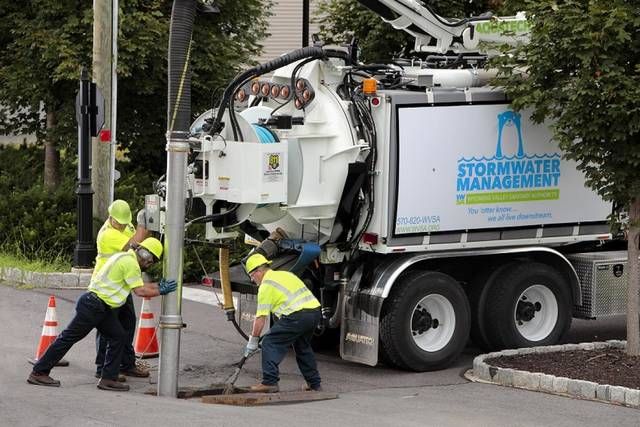Click here to subscribe today or Login.
The owners of 80,408 parcels in 32 Wyoming Valley area municipalities received advance billing notices last week for a new stormwater fee that will take effect Jan. 1.
The fee will fund projects to comply with a U.S. Environmental Protection Agency mandate for municipalities to reduce the quantity of sediment, nitrogen and phosphorus washed into the Susquehanna River and other waterways that feed into the Chesapeake Bay over the next five years.
Instead of going solo, officials in the 32 municipalities determined it would be more cost efficient to participate in a regional compliance plan handled by the Wyoming Valley Sanitary Authority.
The following municipalities are participating the authority program: Ashley, Courtdale, Duryea, Edwardsville, Exeter, Forty Fort, Harveys Lake, Hughestown, Kingston, Laflin, Larksville, Luzerne, Nanticoke, Pittston, Pringle, Sugar Notch, Swoyersville, Warrior Run, West Pittston, West Wyoming, Wilkes-Barre, Wyoming, Yatesville and the townships of Hanover, Jackson, Jenkins, Lehman, Newport, Pittston, Plains, Plymouth and Wilkes-Barre.
Estimated at $33 million, the authority’s proposed solution to reduce runoff pollution includes work on the Toby Creek impounding basin off Division Street in Pringle to make it more absorbent; stream bank restoration along Solomon Creek on the east side of the river; and enhancements at a Plymouth detention basin, Abrahams Creek near the county recreational complex in Forty Fort, and another water collection area in Hanover Township.
In addition, authority workers already have swept more than 1,072 streets, cleaned 395 catch basins and cleared 1,035 cubic yards of debris in participating municipalities, said Donna Gillis, the authority’s public relations and regulatory liaison.
Fee amounts
According to Gillis:
The fee is based on the amount of nonabsorbent “impervious area” containing structures, paved parking lots and sidewalks within each parcel.
This impervious square footage was tallied using aerial photography and mapping data. Authority bills and charts call the impervious area “IA.”
Each parcel will fall into one of four groups that determine how much is paid:
• There is no fee if the IA is 99 square feet or less. This would apply to undeveloped parcels or those containing only a tiny structure, such as a shed.
A total of 3,169 parcels fall into this category.
• The fee is $1 per month — $12 a year — for parcels with an IA ranging from 100 to 499 square feet.
The number of parcels in this category: 2,599.
• A monthly fee of $4.80 will be charged — $57.60 per year — for parcels with an IA ranging from 500 to 6,999 square feet.
Most residential parcels fall into this category — 66,249.
• The highest monthly fee — $1.70 for each 1,000 square foot of IA — will be charged for parcels with an IA of 7,000 square feet or more.
A total 8,391 parcels are in this category — most commercial and industrial properties.
The average IA of commercial properties is 45,741 square feet, which equates to a stormwater fee of $77.76 per month, or $933.12 annually.
The fee will be listed separately and added to sanitary bills for existing authority customers and issued separately for property owners in municipalities that don’t rely on the authority for wastewater treatment.
Fee revenue will be deposited in a dedicated fund for compliance with the mandate, Gillis said.
Public information
The authority opted to send the advance billing notices after receiving feedback that many were unaware of the fee, she said.
“We’ve been out there a year-and-a-half now trying to get the word out, but once we sent the direct mail, that’s when a lot of people started paying attention,” Gillis said.
The authority recently revamped its website — www.wvsa.org — to provide extensive data on the stormwater mandate and provide a way for fee payers to submit questions and concerns.
In addition to meetings at various municipalities, authority representatives held more than 40 sessions with commercial property owners to provide an overview of the program, she said.
The public also is invited to the authority’s next meeting at 5:30 p.m. Dec. 18 at the treatment plant and administration offices, 1000 Wilkes-Barre St., Hanover Township.
Authority representative also will hold an informational meeting on the new fee at 3 p.m. Thursday, Dec. 13, at the Plymouth Township Municipal Building, 925 W. Main St.
Some people are calling the new fee a “rain tax,” Gillis said.
“If it was a tax, it would have been much higher and be issued by municipalities,” she said.
Authority officials offered to handle compliance on behalf of participating municipalities, believing a regional approach would yield efficiencies.
For example, each municipality contributed $3,000 toward a master plan that would have cost each smaller municipality an estimated $20,000 to complete individually — more for larger ones, authority representatives have said.
With the regional plan, municipalities receive credit for pollution reduction throughout the participation zone.





